No dramatic changes may have taken place in the world of HDR over the past few months but here’s a major update of the HDR Ecosystem Tracker. How so? Well, first of all, this time for the first time it includes an actual ecosystem, rather than what some may call a ‘logo farm’. That is, I’ve attempted to put the different parts of the ecosystem into context, showing how they relate to each other.
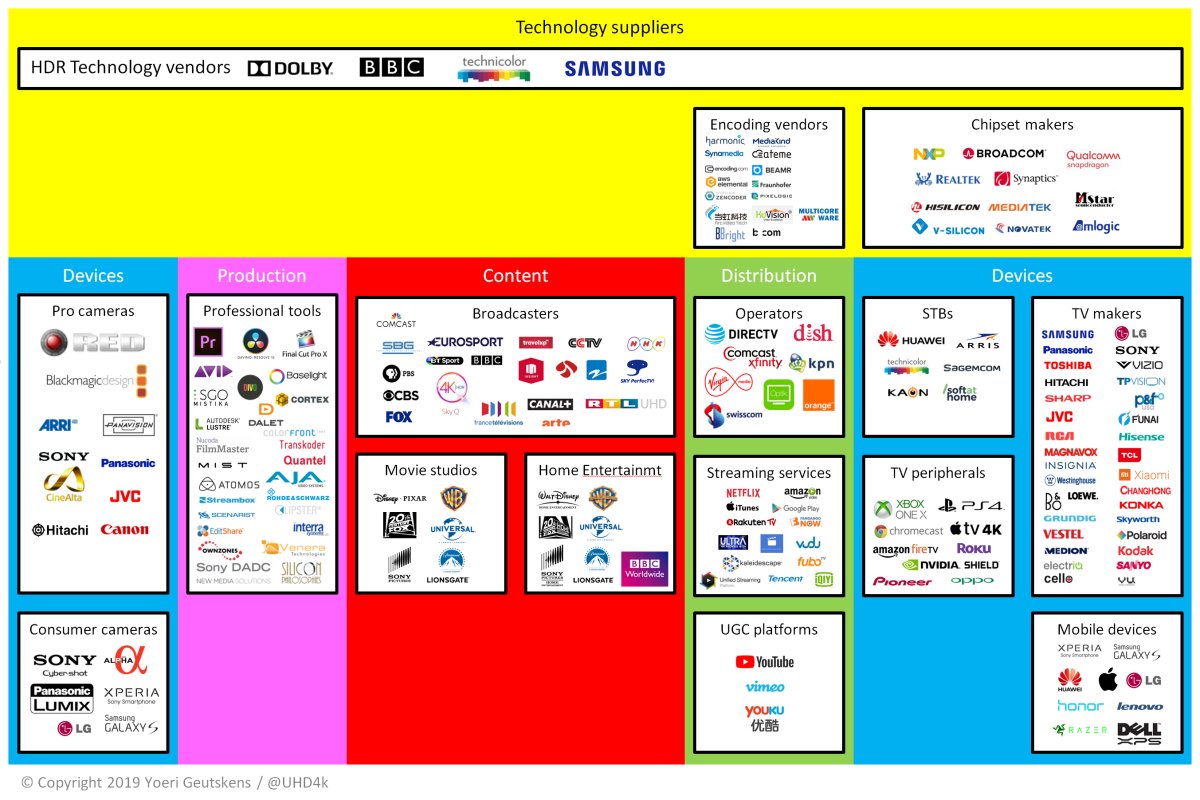
Note that just about every box has a fair number of companies participating, except the broadcaster one, when you realize how many thousands of broadcasters there are worldwide. And bear in mind that most entries here are merely trials. There are very few channels broadcasting HDR on a regular basis. The two main ones are special interest documentary channels, made available via satellite to cable and IPTV operators, MSOs and MVPDs – Insight TV and TravelXP 4K. We’re just witnessing the first sports channel announcement now, from BT Sport.
This new ecosystem view (above) does not distinguish between different types of HDR. I’ve come up with a way to visualize that using this chart but I’ll probably share that in a future update, as I expect it to show some interesting things.
Secondly, I’ve split the TV brands and manufacturers chart into four separate ones representing different geographic regions – North America, Europe, Japan and China. This is because the HDR situation for a number of brands is too confusing, and this is due to the same brands being licensed to different TV makers across the world.
Thirdly, I’ve added a number of new charts, namely the following:
- Consumer digital cameras; these include smartphone cameras.
- Mobile devices, i.e. smartphones (as displays/consumption devices), tablets and notebooks;
- Professional tools i.e. post-production, mastering and authoring tools.
Lastly, I’ve added a fair amount of companies that were thus far missing in the existing diagrams, including some Ultra HD Forum member companies.
For a more extensive background explanation please check the previous issue of the HDR Ecosystem Tracker. Here are the changes since December 2018 in detail:
TV sets
These TV brands are newly added: Medion, Metz (EU), Cello (UK), and Xiaomi Mi (China). I’ve also found you can buy HDR TVs from brands Vu and Sanyo in India but overall HDR (and 4K) are not seeing much adoption in the Indian TV market yet. In fact, when you query Amazon.in for “HDR TV” sets you will mainly find “HD-Ready” products. I’ve decided not to create a separate diagram for this market yet.
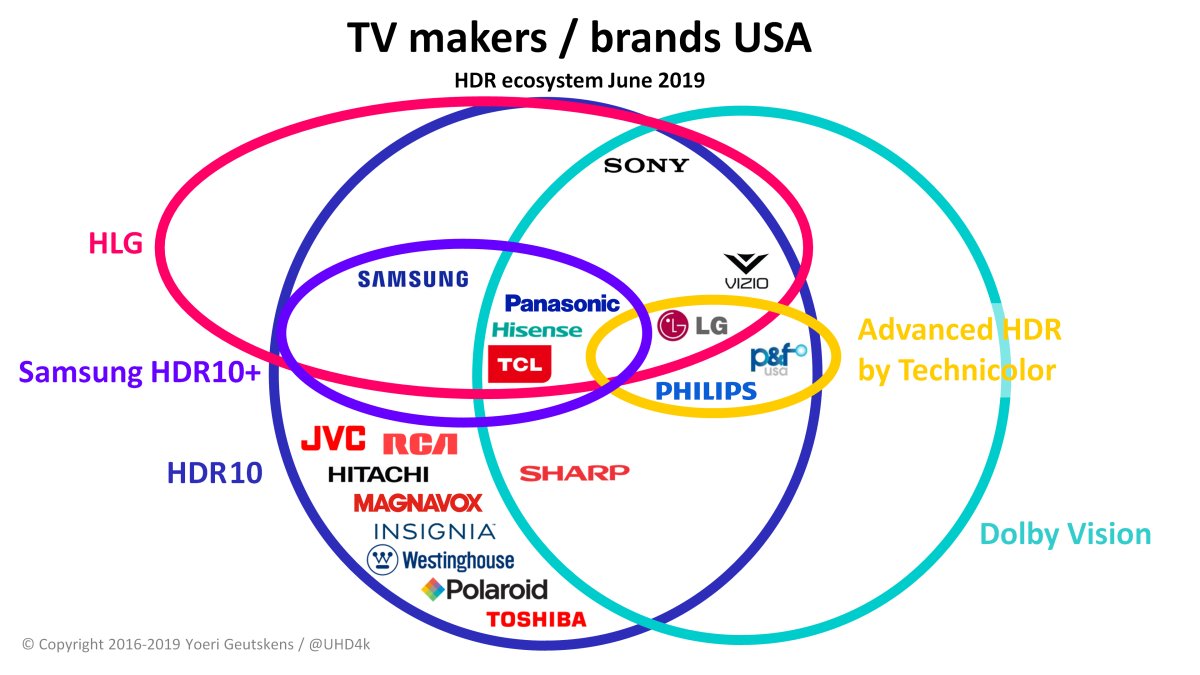
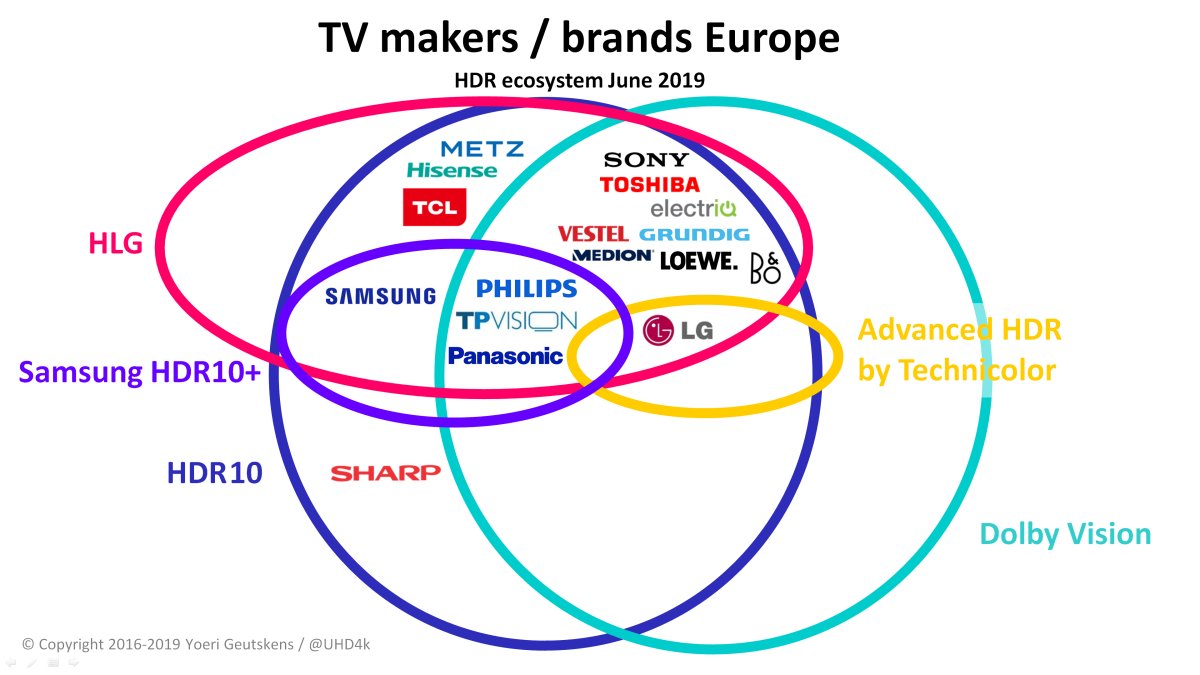
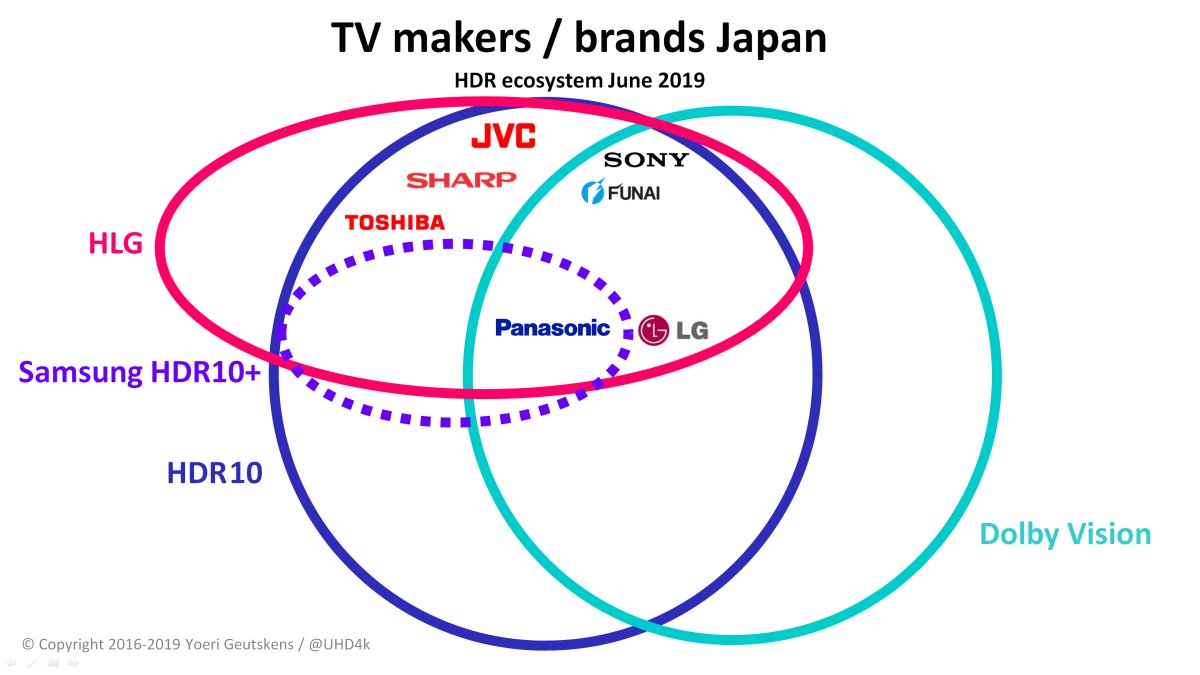
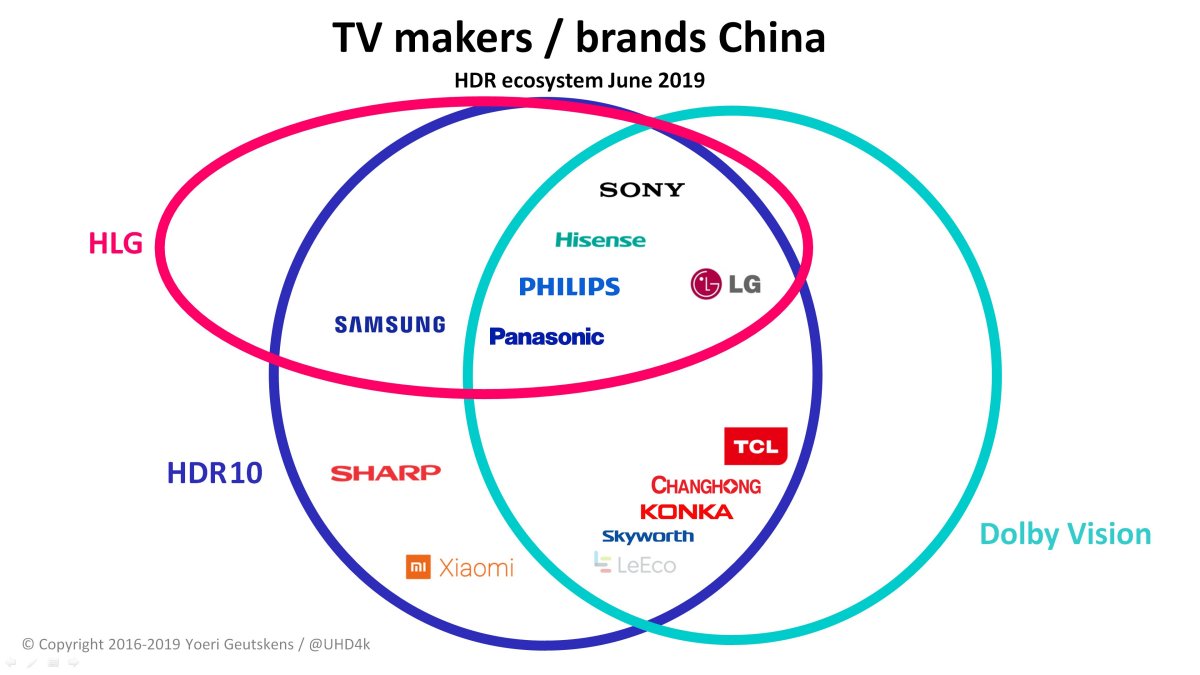
TV Peripherals
It’s confirmed now the Roku Streaming Stick+ supports HLG (for BBC iPlayer).
The following set-top box makers I have added: Huawei, Sagemcom, Changhong. Also added is SoftAtHome. This is actually a middleware vendor for STBs.
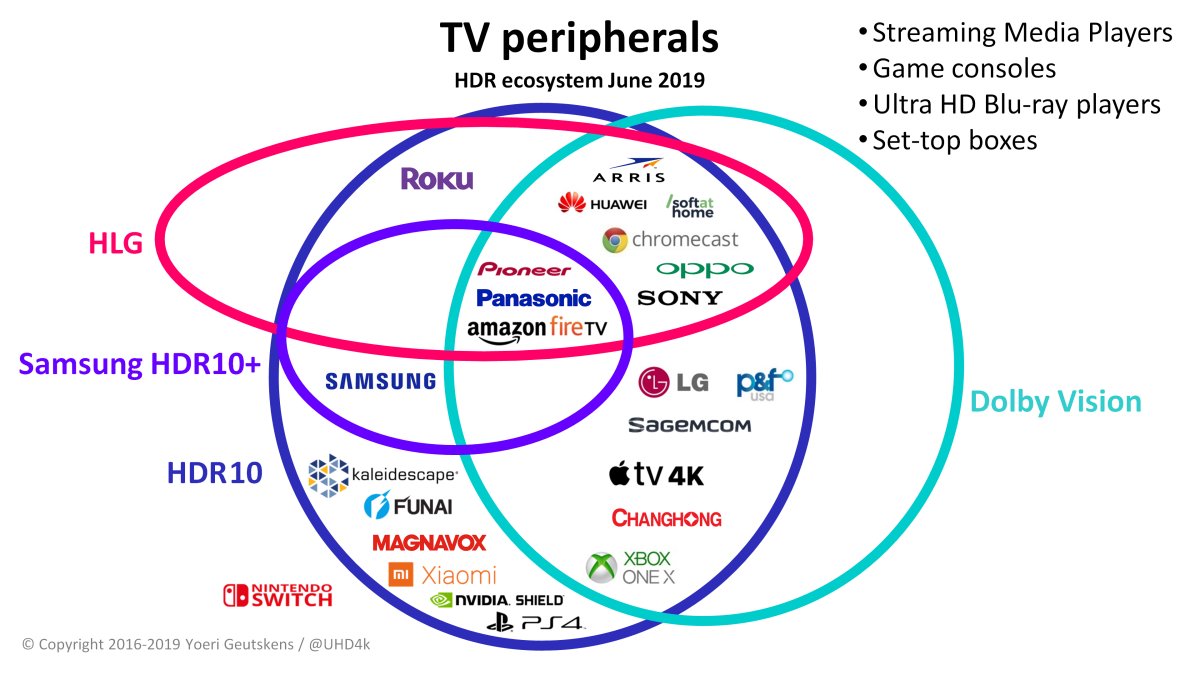
Streaming Services
Perhaps not so well-known in the west but immensely popular in China is Youku, a video streaming service that hosts lots of user-generated content. It supports HDR10. Unified Streaming is not a consumer service but a white-label platform for service providers.
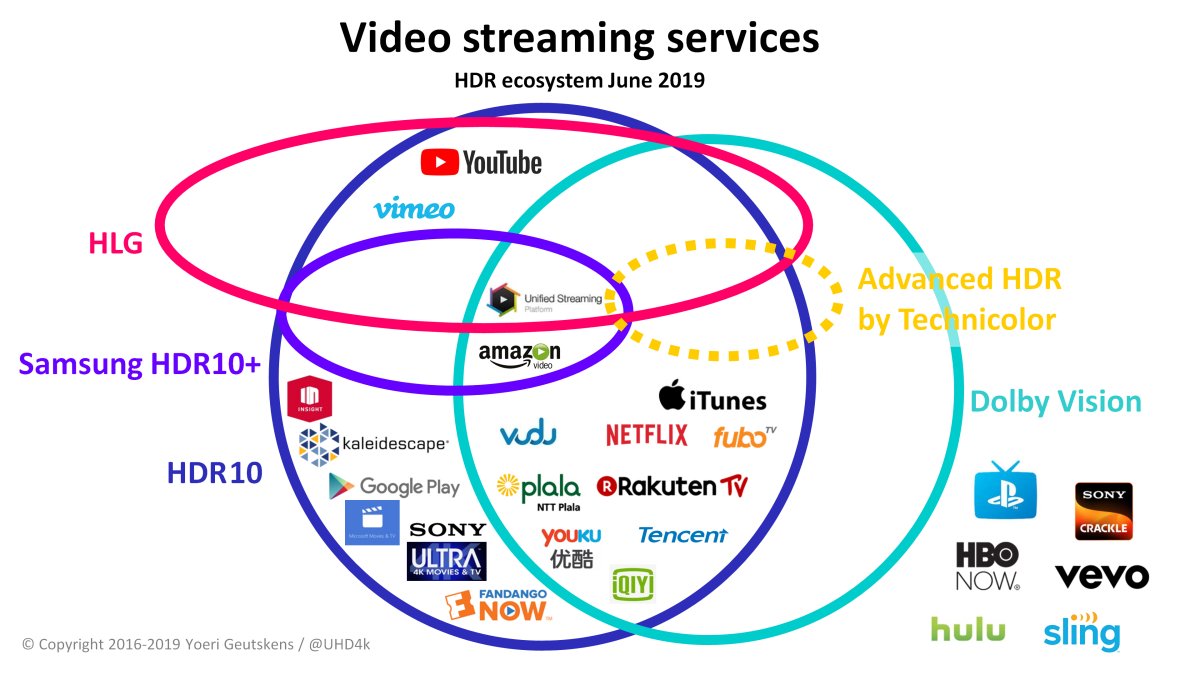
Broadcasters
TV channels and broadcasters added are RTL UHD, Arte*, BT Sport, PBS*, CBS*, FOX*, Sinclair Broadcast Group*, CCTV, Jiangsu* and Zhejiang* (China). An asterisk denotes mere trials. BT Sport had done a (non-public) Dolby Vision trial during the 2017 Champions League final but has recently (late May 2019) announced it will start offering matches in HD HDR, with 4K HDR following later this same year.
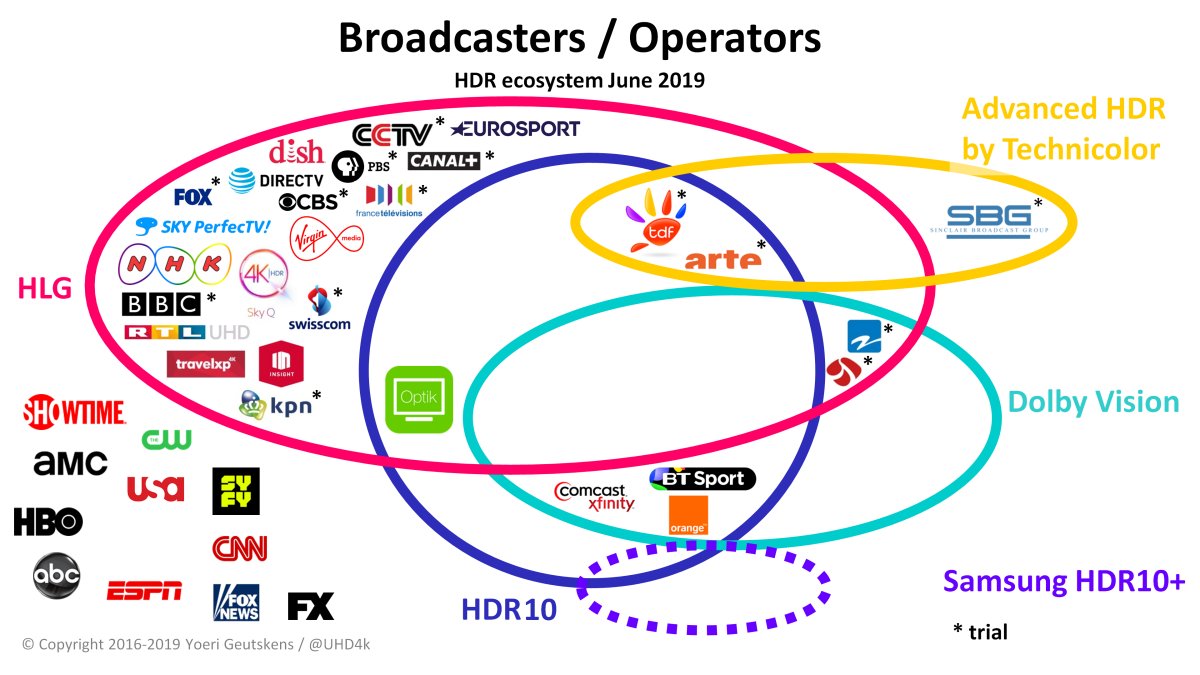
Operators
Most companies in this chart are either broadcasters or operators, but a few are both, such as Sky. This is why I continue to combine these two categories for the time being. With their vertical business model, cable and IPTV operators do not only supply services but also hardware – set-top boxes if you will, or ‘consumer premises equipment’ (CPE). I’ve added France’s Orange. Its UHD TV decoder supports Dolby Vision; what other formats is not clear but surely HDR10. Comcast’s Xfinity Xi6 in the meantime can also handle Dolby Vision. Virgin Media UK's V6 set-top box must already have been capable of outputting HDR but so far that capability went unused. As of this week, VM is first utilising the feature by transmitting Roland-Garros in 4K with HLG. In Switzerland, Swisscom does the same (with a feed provided by Eurosport).
Franco-German channel Arte has done an HDR trial testing various formats with a great number of partners including TDF. I have not included all participants here. Another consideration I want to share here is why (apart from Sky) I will probably not include satellite operators like SES/Astra and Eutelsat. These companies are agnostic where it comes to HDR formats; they merely pass on the bits in a digital transmission.
Movie Studios
In the field of motion pictures studios’ home entertainment divisions, things are converging further. Universal Pictures has joined the HDR10plus Alliance. Lionsgate has released its first Ultra HD Blu-ray with HDR10plus (in addition to Dolby Vision), namely ‘Robin Hood’, and Dolby Vision hold-out 20th Century Fox has released its first Ultra HD Blu-ray with Dolby Vision (in addition to HDR10plus), namely ‘Alita: Battle Angel’. Whether latter development was because of a push by filmmakers James Cameron and Robert Rodriguez or a consequence of Disney’s takeover of 20CF is an open question but feedback from Fox suggests the former. Of course, it could be a combination of the two.
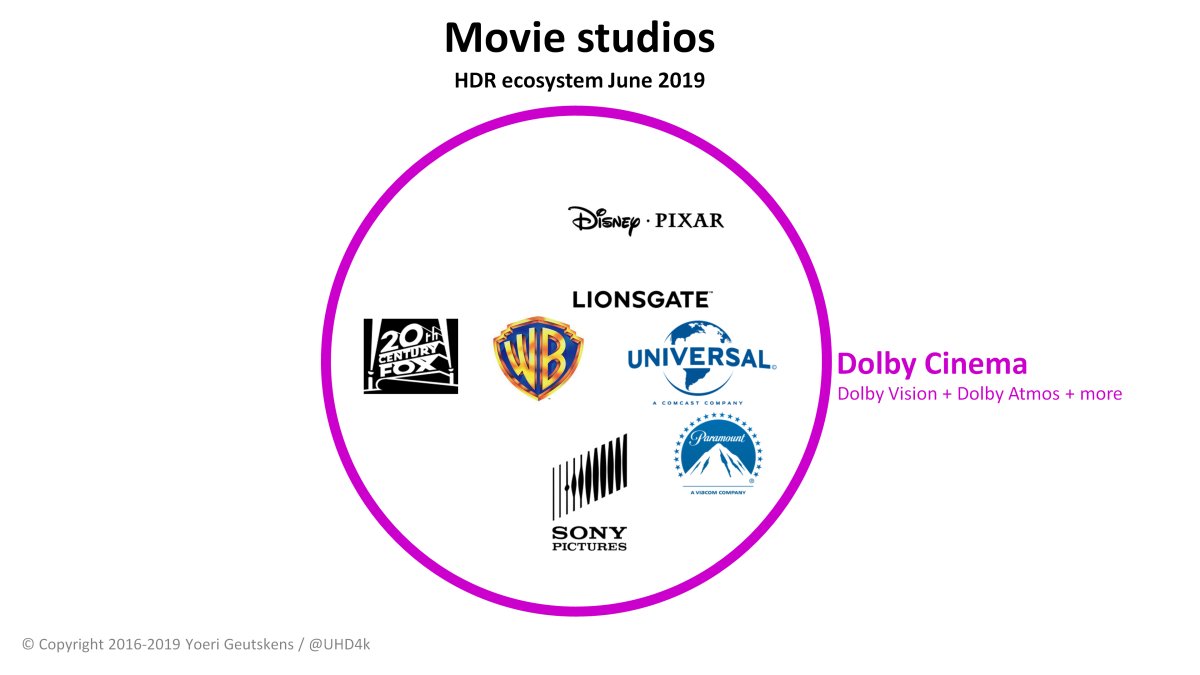
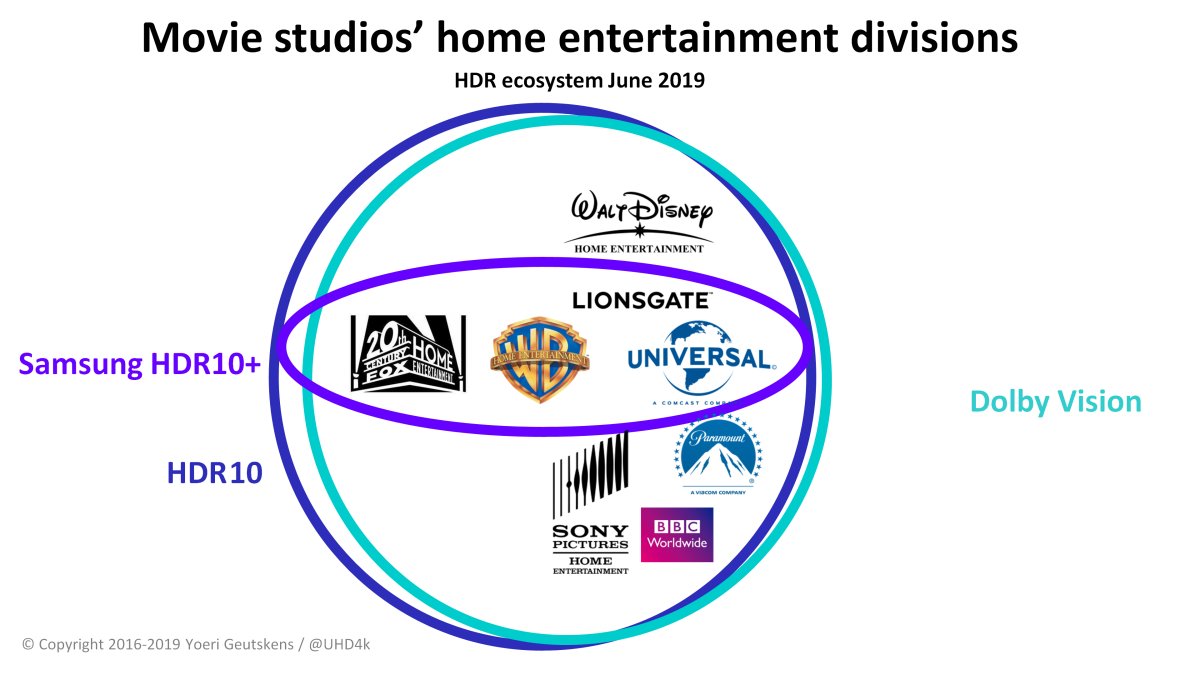
Chipsets
Additional SoC makers that support HDR and are therefore added here are NXP Semiconductors, Synaptics, and Novatek. Sigma Designs is now called V-Silicon following its acquisition.
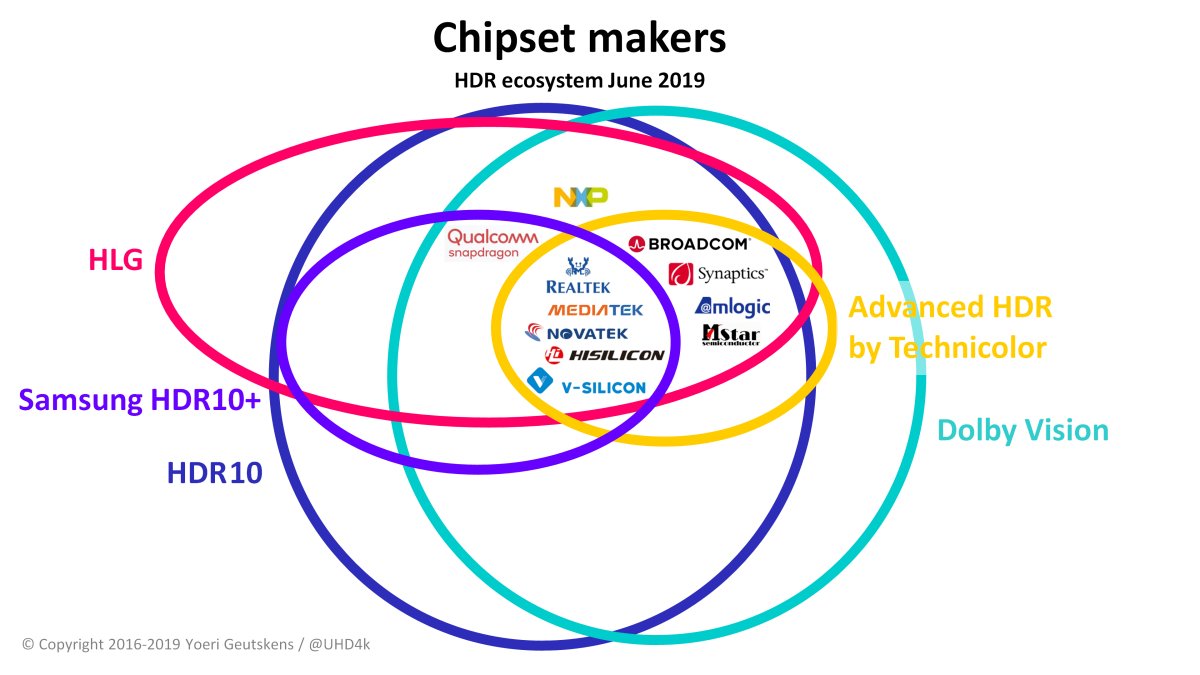
Encoding vendors
Many additions for encoders and encoding services: Brightcove Zencoder, Fraunhofer HHI, Beamr, Encoding.com, Multicoreware, ArcVideo, KuVision (both in the China market) and Pixelogic (encoding for optical disc authoring). Apple Compressor for FCPX seems to support HDR10 and Dolby Vision, perhaps because these two formats are used in iTunes.
Also added here are B:com (SDR/HDR conversion) and BBright (playout solutions), both from from Rennes, France.
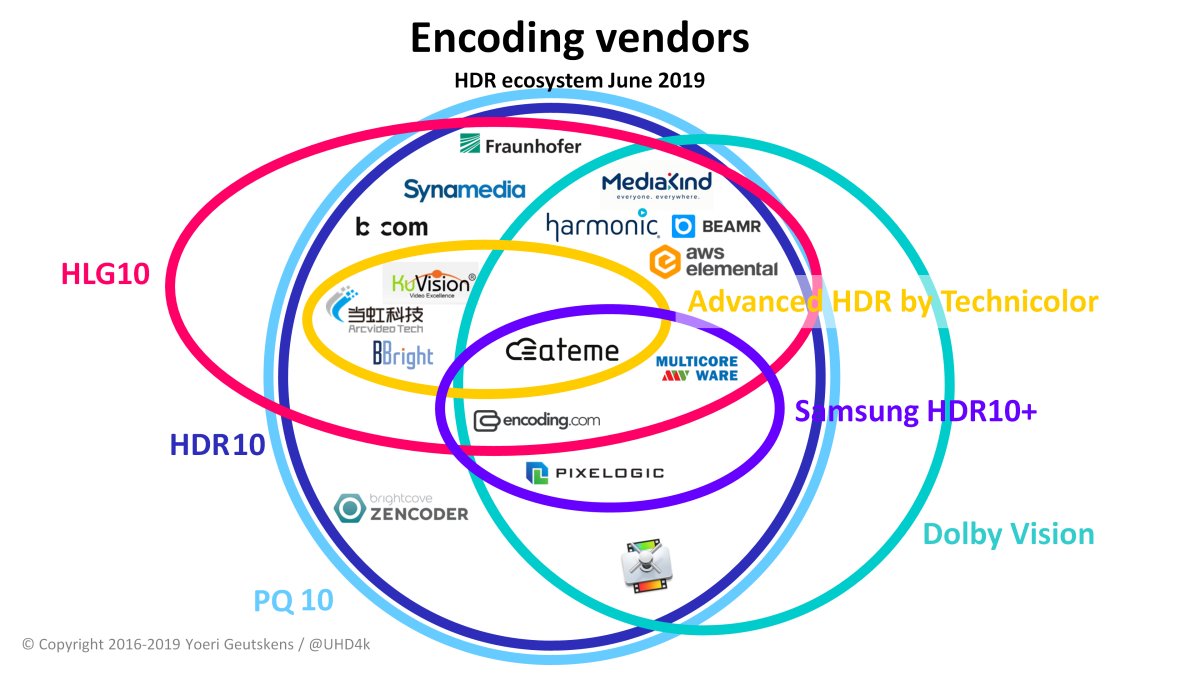
The completely new charts here are the following:
Mobile devices (smartphones, tablets, notebooks)
Unlike TV sets, mobile phones supporting HDR are still few and far between. The Mobile brands leading the pack supporting HDR are Sony Xperia, Samsung Galaxy S, LG, Huawei, Honor (a subbrand of Huawei) and OnePlus. The Apple iPhone XR and iPad Pro support HDR10 and Dolby Vision content, although it’s debated whether their screens are actual HDR displays. I’ve included Apple anyway.
Also added here, so as not to let the number of diagrams proliferate too far, are HDR-capable laptops from Dell (under their XPS subbrand), Lenovo and Razer.
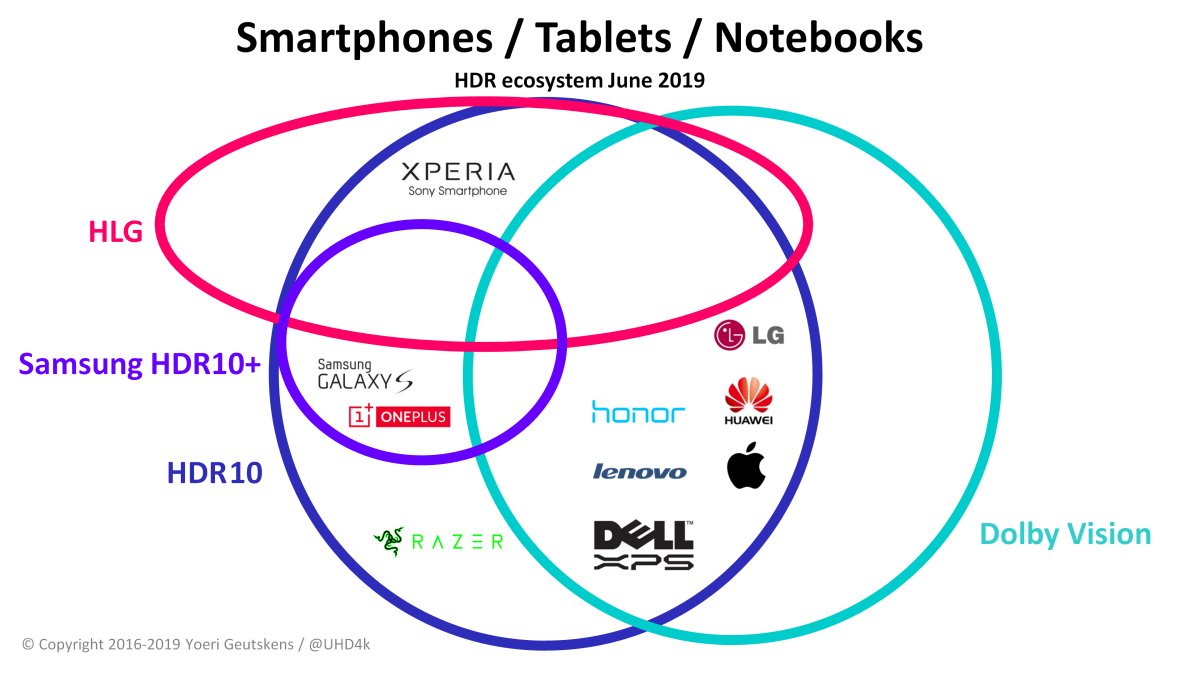
Digital consumer cameras (including smartphones)
This category covers cameras built into phones, point-and-shoot cameras as well as more serious (DSLR or mirrorless) still picture cameras offering video shooting. Not included are professional (studio) cameras. More about that at the end of this piece.
Note that smartphones can support HDR on the camera side (capture) as well as on the display side (viewing) but the HDR formats supported on either side may differ. This is why I’ve listed smartphone cameras here rather than combining them with the previous category.
Brands covered include Panasonic Lumix, Sony Alpha, Sony Cyber-shot, Sony Xperia, LG and Samsung Galaxy S.
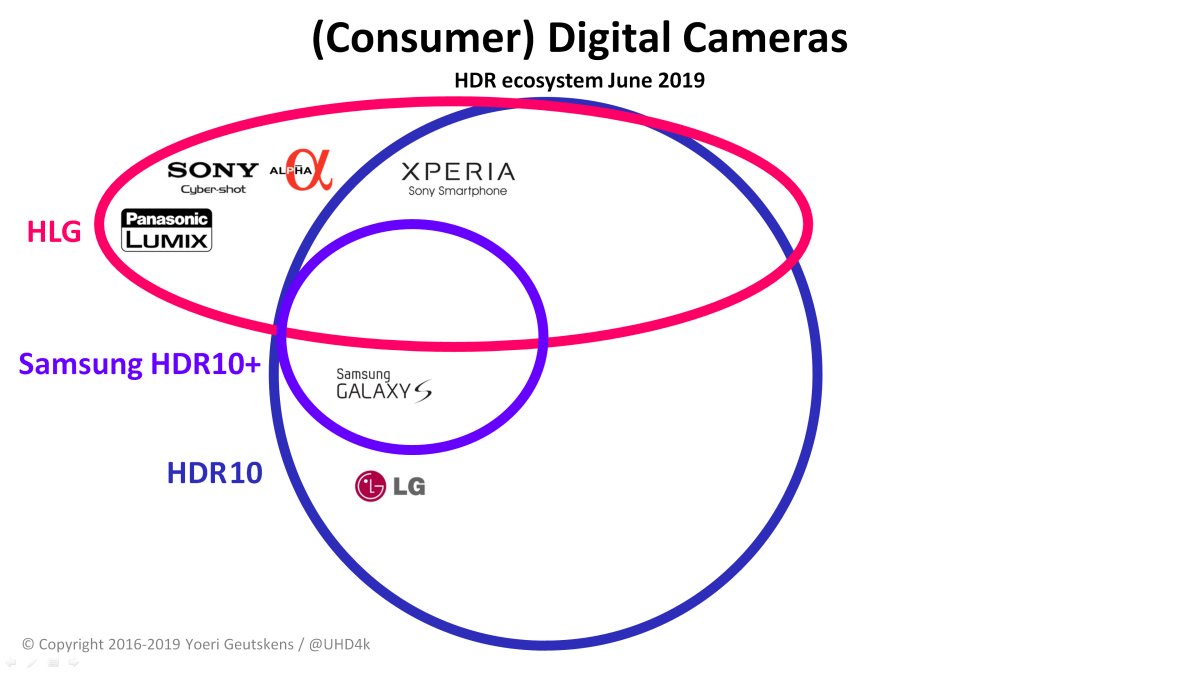
Production, Post-Production, Mastering, QC and Authoring Tools
The last category added is a highly important one but one not very much in the public eye – the companies creating the products that enable content creators to produce great-looking HDR video.
Now one might think that at post-production level, tools don’t need to distinguish between different PQ formats. After all, as Dolby is keen to emphasize, metadata can be generated later in the production workflow, at the encoding stage. So a tool would maybe just need to distinguish between HLG and PQ, observe a certain color space (Rec.709 or Rec.2100), a certain peak brightness level (1000 nits, 10,000 nits, or some value in between) and work with a specific color depth (10 or 12 bits). However, there different types of metadata to distinguish here and some you’ll want to capture already in the post-production stage, such as the characteristics of the mastering monitor used. This is one of the reasons why many post-production tools have Dolby Vision extensions.
Note that PQ10 support may not be represented fully correct here as many vendors don’t commonly mention this format in their specs yet. Encoding vendors are the only ones where that is common practice.
Perhaps this new chart will require splitting up into separate sections (also in the ecosystem view, the fist diagram here) but for now I’ve added the following groups of tools/vendors:
Production: Atomos, ColorFront Transkoder
Post-Production: Davinci Resolve, Avid Media Composer, Apple Final Cut Pro X, Adobe Premiere Pro, Filmlight Baselight, Nucoda FilmMaster, Autodesk Lustre, Quantel Rio, Streambox Chroma;
Mastering: MTI Film Cortex, Marquise Technologies MIST (Media Ingest Stream Transcode), Rohde & Schwarz Clipster, Fraunhofer IIS easyDCP
Quality Control: SGO Mistika Boutique, Dalet AmberFin, Divo, AJA Video Systems HDR Analyzer, EditShare, Interra Systems, Venera technologies
Authoring: Scenarist UHD; Sony DADC/NMS, Silicon Philosophies DVDLogic KITe authoring suite
Digital Supply Chain: Ownzones
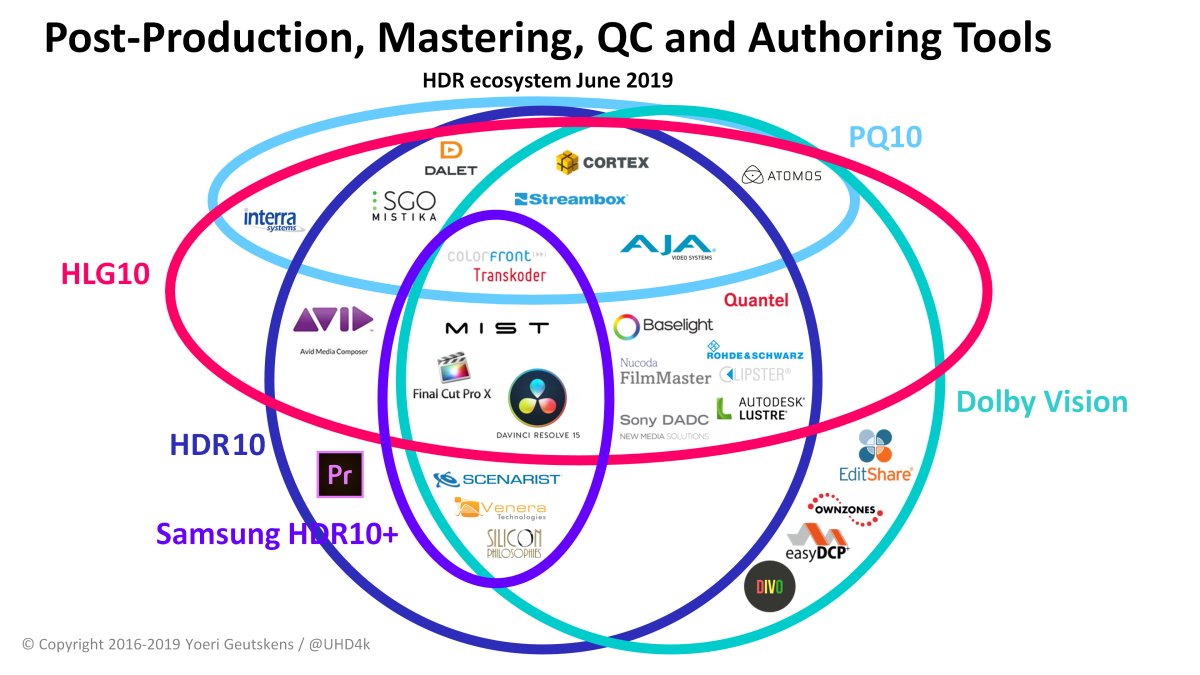
Other categories
At least one category I haven’t covered yet – professional video cameras. They are nevertheless essential. Without HDR cameras no HDR content (other than scanned or rendered content). Several professional camera manufacturers now offer HDR cameras including RED, BlackMagic Design, Arri, Panavision, Sony Cinealta, Panasonic, Hitachi-Kokusai, Canon and JVC. The reason I have not created a venn diagram of these is that the HDR formats used in distribution don’t apply here. They typically don’t output something like HDR10 but either some RAW format such as BMRAW or ProRes Raw, or some proprietary Log format like RED Wide Gamut Log3G10, Arri’s Alexa LogC, Sony’s S-Log3, Panasonic’s V-Log, JVC’s J-Log1, or Canon’s C-Log. In a venn diagram that’s going to be a vast number of small ellipses with very little overlap.
The rest...
What about companies that are stuck in SDR-only territory? Is it useful that I include them in these diagrams, outside of the circles and ellipses? Should I identify and list them?
For broadcasters there’s really no beginning and no end to it. For TV makers it seems doable though. I’ve had to search a while to find any. In the U.S. only budget brands Sceptre and Dynex (a BestBuy private label); in India there are more: Shinco, Mitashi, CloudWalker, Micromax, Intex, QFX, BPL.
In the console area it gets really surveyable: Nintendo is the one real hold-out.
Notable streaming services still lacking any HDR support include Hulu, HBO Now, PlayStation Vue, Sony Crackle, Sling, Vevo.
Conclusion
The HDR Ecosystem is massive and growing. All parts of the production and delivery chain are covered, but there are definite differences between the HDR formats and the extent to which they cover the full chain. The field with the poorest coverage is clearly broadcasters, and operators have a lot of catching up to do as well. As far as multi-HDR format support is concerned, the trend is certainly converging (except in broadcast, where it makes no sense to support more than a single format) though in TV hardware we have yet to see the first truly universal offering.
This view of the HDR ecosystem is a snapshot of a work in progress. I’ll keep tracking the industry and keep adding (or moving) companies where relevant. Don’t hesitate to reach out if you’ve got suggestions for further improvements.
Yoeri Geutskens has worked in consumer electronics and telecommunications for two decades. He works as a consultant in media technology and writes about high-resolution audio and video. You can find his blogs about Ultra HD at
@UHD4k and
@UltraHDBluray.